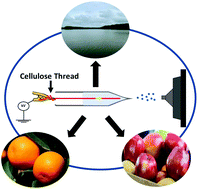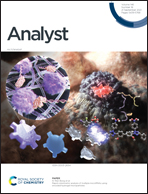Enhanced thread spray mass spectrometry: a general method for direct pesticide analysis in various complex matrices†
Abstract
Determination of pesticide residues in a wide variety of matrices is an ongoing challenge due to low concentration and substantial amounts of interfering endogenous compounds that can be coextracted with the analytes. Herein, we describe the use of cellulose thread both as a suitable sampling medium for various matrices and as a direct analysis platform through an improved thread spray mass spectrometry (MS) approach. Enhanced extraction and the subsequent generation of tiny nanodroplets, after the application of DC potential to the wet thread, enabled ultra-sensitive detection of pesticides without prior sample treatment. This methodology was applied to quantify glyphosate and its metabolite, aminomethylphosphonic acid, in surface water at 12.2 μg mL−1 limit of detection (LOD) via standard addition calibration. The method was also used for an internal standard calibration for the analysis of atrazine, which resulted in a LOD of 0.74 ng mL−1. The enhanced thread spray MS platform also proved effective when applied for direct analysis of diphenylamine and thiabendazole, which enabled the evaluation of post-harvest pesticide treatment of fruits (surface and interior) without complete destruction of the fruits.



 Please wait while we load your content...
Please wait while we load your content...